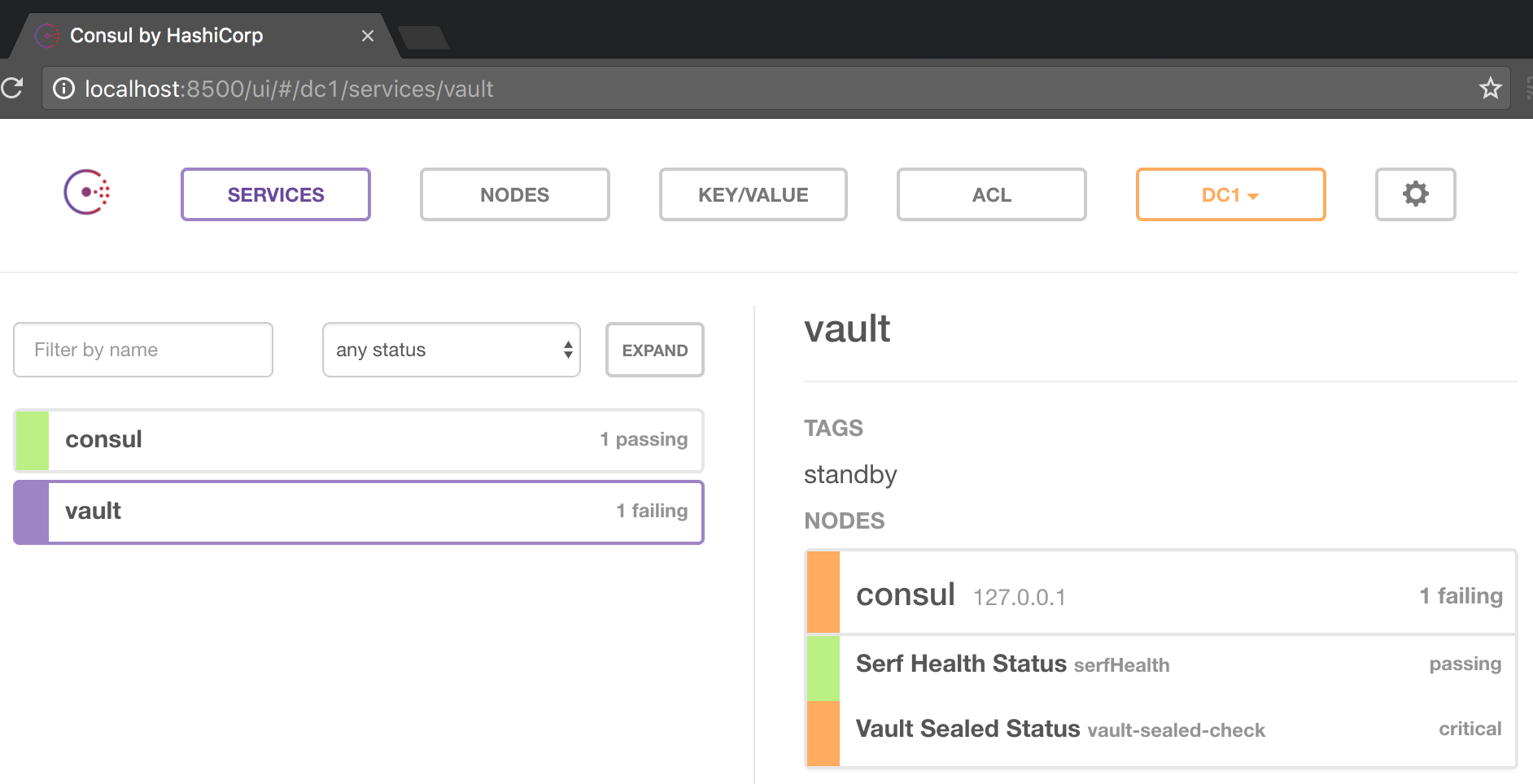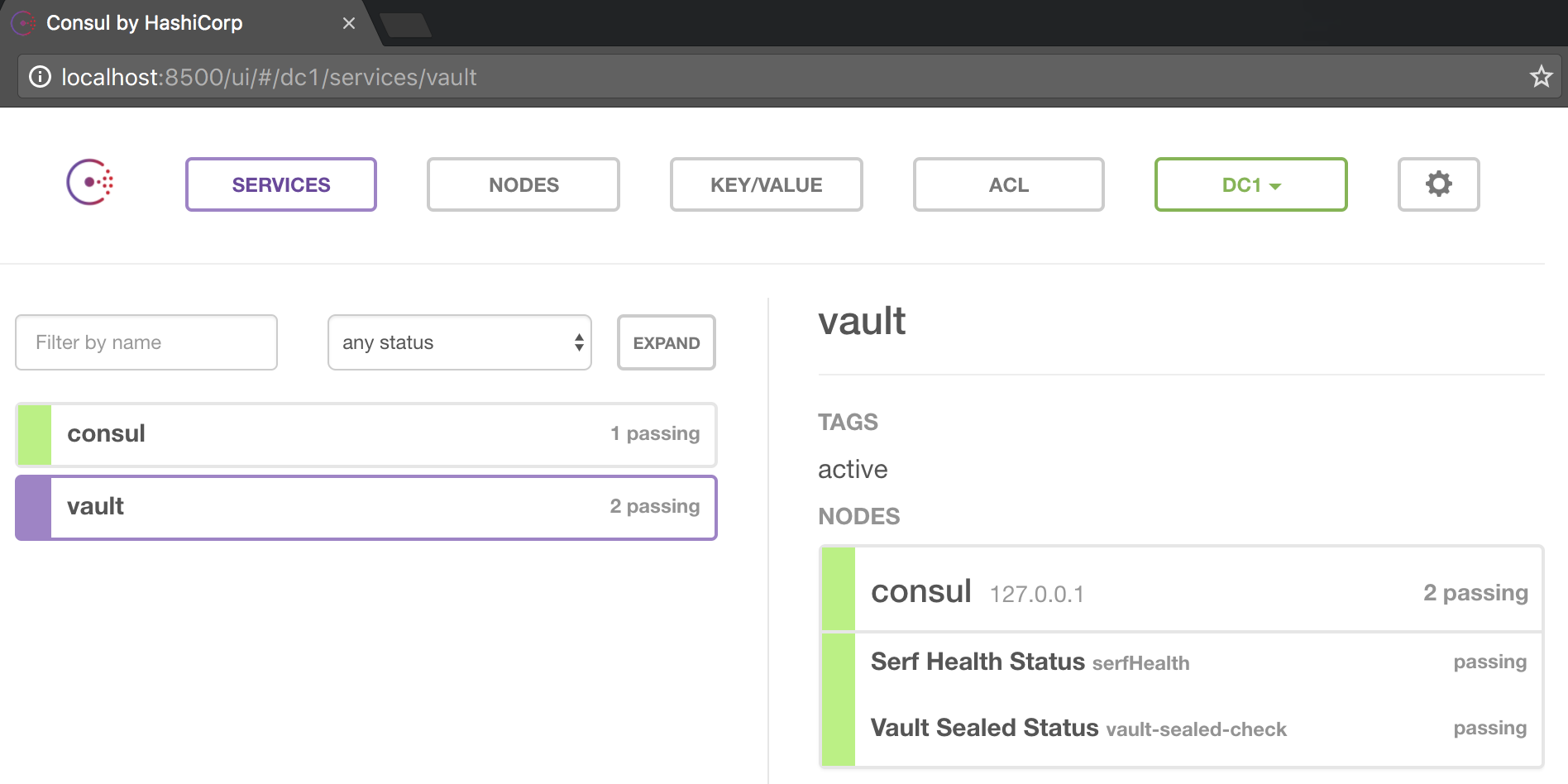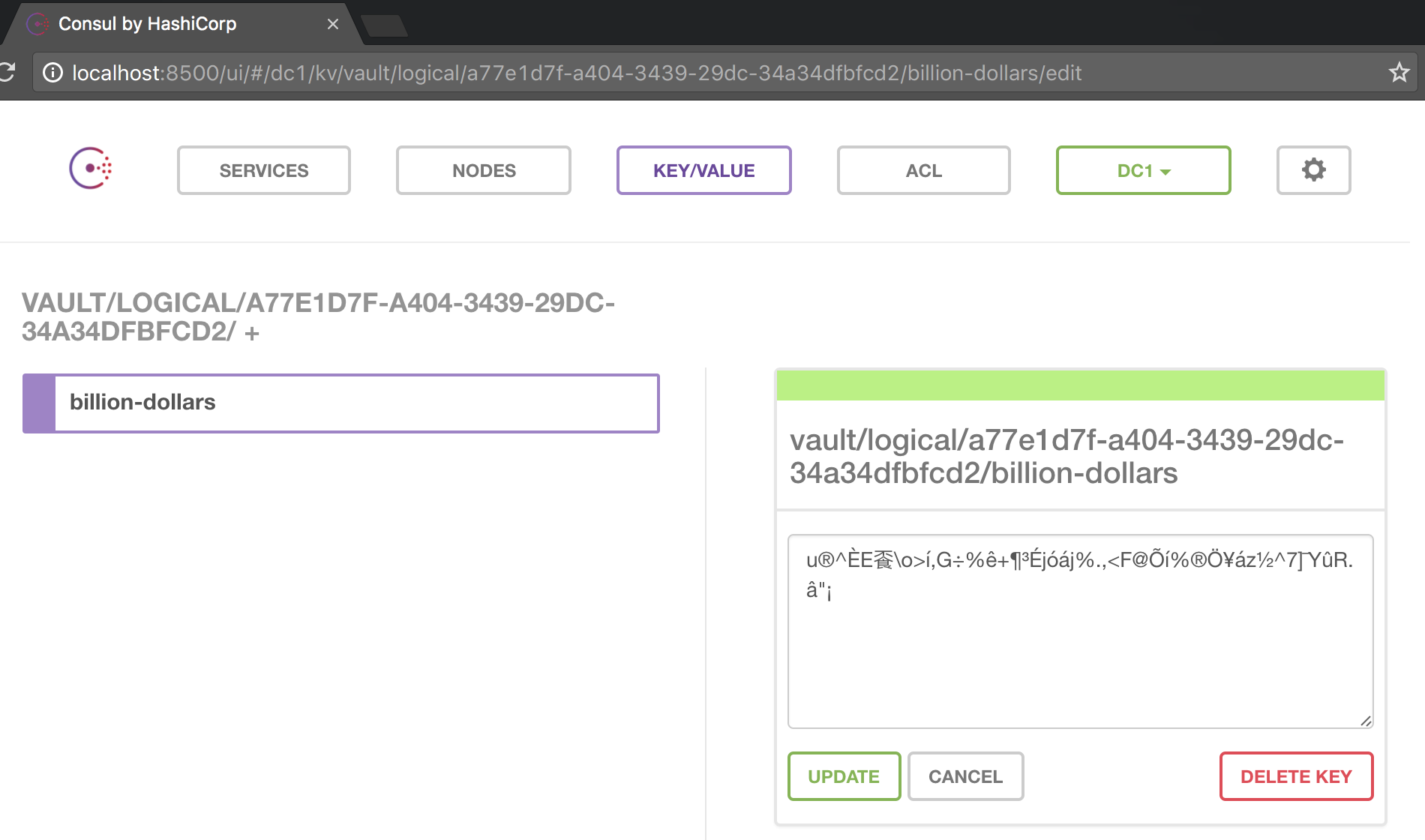Consul and Vault are started together in two separate, but linked, docker containers.
Vault is configured to use a consul secret backend.
docker-compose up -dLogin to the Vault image:
docker exec -it cault_vault_1 shCheck Vault's status:
$ vault status
Error checking seal status: Error making API request.
URL: GET http://127.0.0.1:8200/v1/sys/seal-status
Code: 400. Errors:
* server is not yet initializedBecause Vault is not yet initialized, it is sealed, that's why Consul will show you a sealed critial status:
$ vault operator init
Unseal Key 1: d28dc3e20848c499749450b411bdc55416cefb0ff6ddefd01ec02088aa5c90aa01
Unseal Key 2: ad2b7e9d02d0c1cb5b98fafbc2e3ea56bd4d4fa112a0c61882c1179d6c6585f302
Unseal Key 3: c393269f177ba3d07b14dbf14e25a325205dfbf5c91769b8e55bf91aff693ce603
Unseal Key 4: 87c605e5f766d2f76d39756b486cbdafbb1998e72d2f766c40911f1a288e53a404
Unseal Key 5: e97e5de7e2cdb0ec4db55461c4aaf4dc26092cb3f698d9cc270bf19dbb82eab105
Initial Root Token: 5a4a7e11-1e2f-6f76-170e-b8ec58cd2da5
Vault initialized with 5 keys and a key threshold of 3. Please
securely distribute the above keys. When the Vault is re-sealed,
restarted, or stopped, you must provide at least 3 of these keys
to unseal it again.
Vault does not store the master key. Without at least 3 keys,
your Vault will remain permanently sealed.notice Vault says:
you must provide at least 3 of these keys to unseal it again
hence it needs to be unsealed 3 times with 3 different keys (out of the 5 above)
$ vault operator unseal
Key (will be hidden):
Sealed: true
Key Shares: 5
Key Threshold: 3
Unseal Progress: 1
$ vault operator unseal
Key (will be hidden):
Sealed: true
Key Shares: 5
Key Threshold: 3
Unseal Progress: 2
$ vault operator unseal
Key (will be hidden):
Sealed: false
Key Shares: 5
Key Threshold: 3
Unseal Progress: 0the Vault is now unsealed:
We can use the Initial Root Token from above to auth with the Vault:
$ vault login
Token (will be hidden):
Successfully authenticated! You are now logged in.
token: 5a4a7e11-1e2f-6f76-170e-b8ec58cd2da5
token_duration: 0
token_policies: [root]All done: now you have both Consul and Vault running side by side.
From the host environment (i.e. outside of the docker image):
alias vault='docker exec -it cault_vault_1 vault "$@"'This will allow to run vault commands without a need to logging in to the image.
the reason commands will work is because you just
auth'ed (logged into Vault) with a root token inside the image in the previous step.
In one terminal tail Consul logs:
$ docker logs cault_consul_1 -fIn the other terminal run vault commands:
$ vault write -address=http://127.0.0.1:8200 secret/billion-dollars value=behind-super-secret-passwordSuccess! Data written to: secret/billion-dollars
Check the Consul log, you should see something like:
2016/12/28 06:52:09 [DEBUG] http: Request PUT /v1/kv/vault/logical/a77e1d7f-a404-3439-29dc-34a34dfbfcd2/billion-dollars (199.657µs) from=172.28.0.3:50260Let's read it back:
$ vault read secret/billion-dollarsKey Value
--- -----
refresh_interval 2592000
value behind-super-secret-password
And it is in fact in Consul:
NOTE: for these examples to work you would need jq (i.e. to parse JSON responses from Vault).
brew install jqorapt-get install jqor similar
Running with a System Secret Backend.
Export Vault env vars for the local scripts to work:
$ export VAULT_ADDR=http://127.0.0.1:8200
$ export VAULT_TOKEN=5a4a7e11-1e2f-6f76-170e-b8ec58cd2da5 ### root token you remembered from initializing VaultAt the root of cault project there is creds.json file (you can create your own of course):
$ cat creds.json
{"username": "ceo",
"password": "behind-super-secret-password"}We can write it to a "one time place" in Vault. This one time place will be accessible by a "one time token" Vault will return from a
/sys/wrapping/wrap endpoint:
$ token=`./tools/vault/wrap-token.sh creds.json`
$ echo $token
7c0c0c6a-47c5-58cf-1c7a-a86c7537d795You can checkout wrap-token.sh script, it uses /sys/wrapping/wrap Vault's endpoint
to secretly persist creds.json and return a token for it that will be valid for 60 seconds.
Now let's use this token to unwrap the secret:
$ ./tools/vault/unwrap-token.sh $token
{"password": "behind-super-secret-password",
"username": "ceo" }You can checkout unwrap-token.sh script, it uses /sys/wrapping/unwrap Vault's endpoint
Let's try to use the same token again:
$ ./tools/vault/unwrap-token.sh $token
["wrapping token is not valid or does not exist"]i.e. Vault takes one time pretty seriously.
Running with a Cubbyhole Secret Backend.
Export Vault env vars for the local scripts to work:
$ export VAULT_ADDR=http://127.0.0.1:8200
$ export VAULT_TOKEN=5a4a7e11-1e2f-6f76-170e-b8ec58cd2da5 ### root token you remembered from initializing VaultCreate a cubbyhole for the billion-dollars secret, and wrap it in a one time use token:
$ token=`./tools/vault/cubbyhole-wrap-token.sh /secret/billion-dollars`let's look at it:
$ echo $token
141ad3d2-2035-9d7b-c284-ce119f39fc5dlooks like any other token, but it is in fact a one time use token, only for this cobbyhole.
Let's use it:
$ curl -s -H "X-Vault-Token: $token" -X GET $VAULT_ADDR/v1/cubbyhole/response{"lease_id": "",
"renewable": false,
"lease_duration": 0,
"data": {
"response": {
"lease_id": "",
"renewable": false,
"lease_duration": 2592000,
"data": {
"value": "behind-super-secret-password"
},
"wrap_info": null,
"warnings": null,
"auth": null
}
},
"wrap_info": null,
"warnings": null,
"auth": null}Let's try to use it again:
$ curl -s -H "X-Vault-Token: $token" -X GET $VAULT_ADDR/v1/cubbyhole/response{"errors":["permission denied"]}Vault takes one time pretty seriously.
In case there are some stale / stopped cached images, you might get connection exceptions:
failed to check for initialization: Get v1/kv/vault/core/keyring: dial tcp i/o timeoutreconcile unable to talk with Consul backend: error=service registration failed: /v1/agent/service/registeryou can purge stopped images to solve that:
docker rm $(docker ps -a -q)Copyright © 2017 tolitius
Distributed under the Eclipse Public License either version 1.0 or (at your option) any later version.


